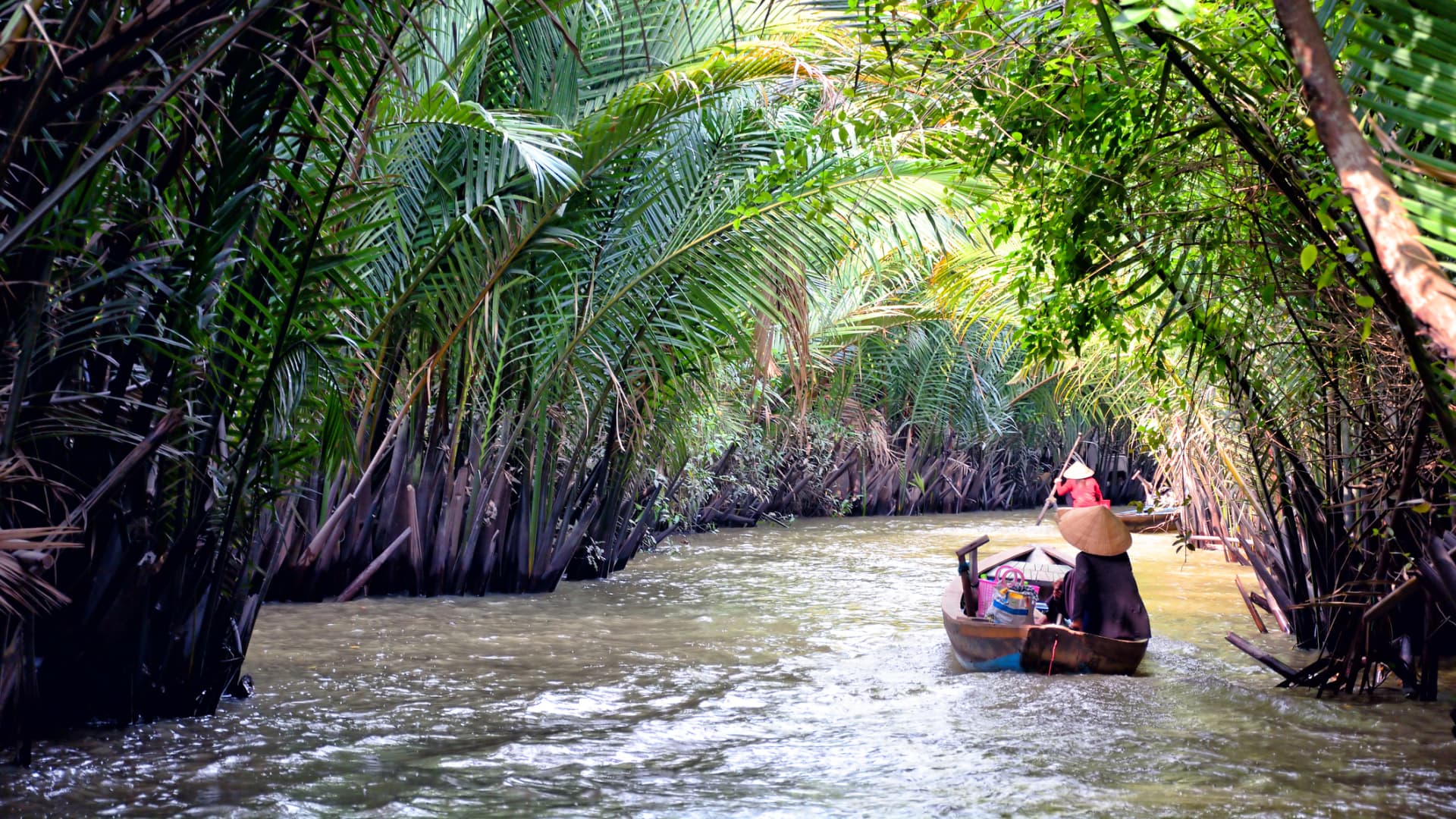I’m a solo female traveler from Europe. Here’s why I chose to go to Vietnam

I wanted a place with great weather, interesting culture, fantastic food and friendly people — and with plenty to see in a week.
So I picked Vietnam, traveling from Ho Chi Minh City through the Mekong Delta area and on to Phu Quoc, an island in the Gulf of Thailand.
Ho Chi Minh City highlights
I’d been warned about congestion in Ho Chi Minh City, which has a population of around 9 million. As my airplane flew low over the city in the evening, I could see the lights of hundreds of mopeds buzzing along its streets.
But in the taxi to my hotel, I was enchanted by its chaotic bright lights and amused by how much people carried on their motorcycles — families of four, plus groceries, were piled atop one bike. I even saw a man balancing a full-length mirror while navigating the highway.
Tips for traveling in Vietnam
- As my vacation was only a week long, I chose to travel around a small part of Vietnam, not wanting to take too many internal flights or spend a long time on the road.
- In two weeks, you could also explore the north, visiting the capital city of Hanoi and trekking through the terraced rice fields around Sapa, as well as seeing the ancient town of Hoi An on the central coast.
The next day, I headed out for an 8 a.m. walking tour organized via GuruWalk, which matches local guides with visitors. A group of about 12 met our guide, Thanh, by a statue of former Vietnam president Ho Chi Minh at the north end of Nguyen Hue, a striking boulevard in the central district of Ben Nghe.
The Ho Chi Minh City People’s Committee Building, formerly known as the Hotel de Ville (town hall), was built in the early 20th century.
Mongkol Chuewong | Moment | Getty Images
Thanh pointed toward a sign on the top of the nearby Rex Hotel that read: “Five o’clock follies,” referring to the U.S. military briefings given to journalists at the hotel during the Vietnam War, which were notoriously unreliable. Its rooftop is now home to a garden bar, which I later found pleasant for an evening drink with a view.
French influence
France began its colonization of Vietnam in 1858 and a block or so away from the Rex Hotel our tour stopped opposite the late 19th-century Saigon Opera House, designed by French architect Eugene Ferret. It’s also a backdrop that proved popular for photographs — I saw two bridal couples swiftly dodge between moving traffic to pose by its steps.
The Saigon Opera House in Ho Chi Minh City is an example of French architecture in the city.
Bob Henry | Ucg | Universal Images Group | Getty Images
Further along the street Thanh showed us the charming Central Post Office, which is also French-designed and largely unchanged since the 1880s. From there, I sent a postcard back home to the U.K. Close by is the twin-spired Notre Dame Cathedral, a red brick building sitting at one end of a square where a statue of the Virgin Mary stands.
The Vietnam War
Reminders of the 1955-1975 Vietnam War — known by many Vietnamese as the American War — are all around the city, including an army tank on the grounds of the Independence Palace that marked the end of the conflict.
North of the palace is the War Remnants Museum, where visitors can see “The Terror of War,” the photograph that became known as “Napalm Girl,” an image of Phan Thi Kim Phuc running naked down the street after a 1972 attack by the South Vietnamese air force.
Lunchtime gatherings
Around lunchtime, I noticed a group of men in business attire sitting on the sidewalk on tiny plastic stools, which is a common way to eat street food in the city.
Men take a break on small stools on the sidewalk in Ho Chi Minh City.
Source: Lucy Handley
Thanh took us to a cafe selling a variety of banh mi, which are baguette-like rolls filled with meat or vegetables and herbs eaten all over Vietnam. Like the workers, we ate our food sitting on small chairs in the shade on the sidewalk.
Where to stay in Ho Chi Minh City
For upscale accommodations, residents I spoke to recommended the five-star Caravelle Hotel, opened in the 1950s by French entrepreneurs Antonin Emery and Marius Mallein, a favorite of American journalists during the Vietnam War. Its rooftop bar, Saigon Saigon, has live bands most nights and guests can choose from three restaurants.
I stayed at the mid-range Silverland Jolie, which is within walking distance from Nguyen Hue. It has a small plunge pool and cocktail bar on its rooftop, plus attentive service.
Although I only stayed a short time, I fell in love with Ho Chi Minh City’s grand architecture, history and general buzz. The city is undoubtedly hectic, but I found the people super friendly — one time, a restaurant employee went out of his way to help me cross the road. The traffic may be eased by the city’s new metro system, set to open later this year.
The Mekong Delta
Southwest of Ho Chi Minh City lies the Mekong Delta, a region of rice paddies, rivers and floating markets. There are many ways to see the area, from homestays to companies that organize more luxurious trips there.
I joined a two-night sightseeing bus and boat trip with Vietnam Adventure Tours, which was well organized and offers numerous excursions and overnight stays in the area. Our first stop was the town of My Tho to see the Vinh Trang Pagoda built in 1849. After seeing monks at prayer, several schoolchildren approached me, asking to practice their English.
Fruit and vegetables are thrown from one boat to another at Cai Rang floating market near Can Tho in Vietnam.
Andrew Woodley | Education Images | Universal Images Group | Getty Images
Then we took to the river itself, where guides rowed our group in small wooden boats down a narrow channel lined with palms, before stopping at Con Quy island to see how coconut candy is produced.
Even though they can be crowded with tourists, the floating markets were a highlight of the Mekong Delta for me, with cone-hatted merchants selling everything from fruit to haircuts from their boats — an experience best seen early in the morning.
Our tour visited Cai Be market, just outside the city of Can Tho, where we tasted freshly cut pineapple with chili salt (surprisingly good) and strong Vietnamese coffee from a seller who moored her boat next to ours.
Tour operators in the Mekong Delta are plentiful, but some trips only run if there’s a minimum number of participants, which can be tricky for a solo traveler. Mekong Eyes is a well-reviewed operator that runs small river cruises on traditional rice barges in southern Vietnam and on to Phnom Penh in Cambodia.
Phu Quoc Island
After a hectic few days of traveling, I booked myself into Cassia Cottage, a beachside resort set in pretty gardens on tropical Phu Quoc Island, which is a short flight from Can Tho or Ho Chi Minh City. There, I lazed on beaches lined with palm trees, wandering into the sea when it became too hot or relaxing by one of three pools with a cucumber martini.
The resort is owned by Mark Barnett, a U.S. expat who spent more than two decades as a major exporter of cassia — or cinnamon — from Vietnam before selling his company to a Japanese firm. I often saw him speaking to guests at mealtimes.
Phu Quoc, an island in the Gulf of Thailand.
Mlenny | E+ | Getty Images
The Spice House, the resort’s excellent restaurant, serves Italian food, alongside Vietnamese dishes like seafood spring rolls and pho.
Staying on a tropical island alone might not appeal to everyone, but I loved being able to choose exactly what I wanted to do and when — whether it was having a massage at Cassia’s small seaside pavilion or heading out to sea on a boat trip to explore more of the island.


